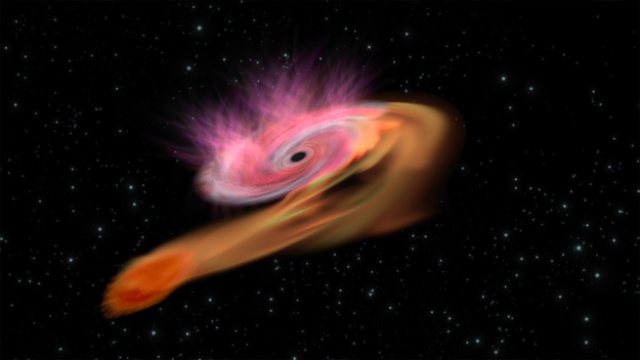The Spektr-RG Space Observatory helped astronomers see the early stages of the event of the tidal destruction of a star by a supermassive black hole in a distant galaxy. The light from the source went to the Earth for 2.5 billion years, further observations of it will help determine the mass of the supermassive black hole and the rate of accretion of matter to it, according to the website of the Institute for Space Research of the Russian Academy of Sciences.
The events of tidal destruction of stars are of great interest to astrophysicists, as they allow us to understand the mechanisms of accretion of matter to black holes and the prevalence of compact objects of this type in galaxies. They occur when a star passes close enough to a black hole for tidal forces to destroy it, while some of the star's matter will be thrown away, and some will form an accretion disk around the black hole. At the same time, scientists are trying to observe the earliest stages of such events, since in this case a more complete picture of what is happening will arise.
On June 6-7, 2021, the eROSITA telescope installed at the Spektr-RG space X-ray Observatory discovered a new source of soft X-ray radiation SRGe J131014. 2+444315, which had not been observed before. Its spectrum can be described by a black body model with a temperature of 50 electron volts and a radiation flux of 3.8×10-13 erg per second per square centimeter. Thanks to subsequent observations using the optical telescope of the Keck Observatory, it was possible to determine that scientists recorded an event of tidal destruction of a star by a supermassive black hole that occurred in a galaxy with a redshift value of z=0.199. This means that the light from the source to the Earth went 2.5 billion years.
In addition, the observations of the ground-based ATLAS system showed that the source's activity in the optical range began 1-2 weeks after the X-ray radiation was recorded, which means that scientists see the early stages of the star's destruction. According to eROSITA and the Swift space ultraviolet telescope, it turned out that an accretion disk was formed around the black hole, with a luminosity close to the Eddington luminosity (at which the gravitational attraction is balanced by the radiation pressure). Further multi-wave observations of SRGe J131014.2+444315 are expected to measure the mass of the supermassive black hole and the accretion rate.
Spektr-RG has been conducting scientific observations since October 2019 and is creating detailed maps of the celestial sphere in the soft and hard X-ray ranges with record sensitivity. It is equipped with two telescopes: the Russian wide-angle ART-XC and the German eROSITA, which are installed on the Russian Navigator platform. According to the plan, Spektr-RG should work for about 6.5 years in space.
Alexander Voityuk

